
I occasionally work at Squamish (CYSE), a small 2000′ airstrip in southern BC that is surrounded by huge mountains and has 80′ tall trees on one approach just 800′ short of the pavement. In the last few years I have seen numerous small aircraft from other airports attempt to land there, often with limited success. Many of these attempts are flown high and fast, resulting in a botched approach followed by a go-around. The pilots often give up and go home without landing, completely unable to fly a successful approach. Some should have given up but didn’t. Four times I have seen pilots overrun the runway and go into the bush, having decided to land No Matter What, forcing the airplane onto the ground long, fast and flat.
If you check my lists of problem areas on flight tests, you will see that flat landings, crappy landings, high fast approaches, long landings, poor energy management, botched forced approaches and botched PFLs figure large in flight test situations as well. All of these things can be put under the headings of “approach management” and “glide judgement”. There are many reasons for these issues, but three are prominent: poor instruction, lack of practice, and poor to non-existent glide judgment and energy management skills. In this discussion, I’ll focus mainly on the last one.
I’ll primarily talk about the C172, but the discussion is pertinent to other types as well. You no doubt have heard the olde adage “a good approach leads to a good landing”. So what makes a good approach? A good approach is a stable approach, which comes down to these things:
-On profile.
-On speed.
-Correct configuration.
-Positive, assertive control.
Let’s look at these individually.
Profile. (Otherwise known as glide judgement.)
Approach profile is the slope of your approach viewed from the side. It should be a straight sloping line, from the top of your approach to the flare, without hills and valleys, and aimed just short of your intended touchdown spot (the flare will use up this extra distance). The same profile will be flown even for short field and obstacle landings. A stable straight-line approach will clear any real-world obstacle in almost every case. (If an obstacle is obscuring the button of the runway from your point of view when you are on final, then you are going low and will collide with the obstacle, and need to raise your approach. Don’t fly a steeper than normal approach to an obstacle clearance landing unless a normal profile causes the obstacle to obscure your landing spot.)
So how do you fly a straight profile? By developing accurate glide judgement. When you are on approach, you are heading toward a point on the ground. The aircraft would impact the ground at precisely that point if you did nothing. That point on the ground is also coming straight toward you. You just need to be able to recognize and control that point, moving it toward and away from you with small power adjustments, so it comes straight into you, and does not go under you. It will move around based on headwind component, up and down drafts, elevator and throttle inputs. You control the the point on the ground with throttle. More power moves the point away from you and less power brings it toward you. With small timely throttle adjustments, you can place the point at the beginning of the runway and keep it there.
“Hang on just a minute,” I hear you saying. “I was taught to judge glide range by looking for the point in the windshield that is not moving”. That’s nice. Many instructors teach that method. It has one small problem, though, and that is this: there IS NO POINT IN THE WINDSHIELD THAT IS NOT MOVING. Every point in the windshield is in constant motion, in response to every tiny head movement or shift of body position, every miniscule control input or change in aircraft attitude, every imperceptible ripple in the air. Searching for an unmoving point is worse than fruitless, inviting fixation and distraction, narrowing the focus to the point of disregarding other cues, visual and otherwise, and sacrificing situational awareness.
So how does it work, then? I don’t know. Ask a neuroscientist. But think of this: you know intuitively whether your car is going to hit an object in the road or miss it, or whether a ball thrown at you will hit or miss you, even if by only millimeters. Your brain carries out the processing, instantly and effortlessly, in real time, with no input from you. You JUST KNOW. Your brain and visual system have evolved to do it. The skill is innate. But consider: you normally live in 2 dimensions. A bit of practice will be required to develop the skill in 3. And, it gets easier the closer you get to the ground.
Practice judging the glide first in the training area. Put the airplane into a descent with an approach power setting and try to recognize where you would hit the ground. Once you get good at that, pick a specific point on the ground in front of you and fly directly toward it, making small power adjustments to control profile, distance and speed. (Please, not below 500’AGL unless dual.) Remember, you don’t want to fly over the point on the ground, you want to fly to it.
After you have done this in the training area, try it at the airport. Your spot that you are flying to will be the button of the runway. You may realize quite soon that you consistently arrive well above your touchdown point with excess speed. Keep practicing until you can fly a straight-line profile to begin the flare just short of your intended target (this may seem low to you at first) using only small adjustments of power.
Flying a straight profile will keep you from flying the dreaded and unprofessional “chop’n’drop” which can lead to hard landings and other problems. It will also make it easier to manage and control the second item:
Speed.
Let me make a sweeping generalization: you are flying your approaches too fast. It’s a safe statement to make as almost everyone does. Let’s look at approach speed selection for a C172M. The POH specifies a range of approach speeds from 55 KIAS to 65KIAS with flaps extended. The reason for this range of speeds is often misunderstood. Both speeds refer to the aircraft at maximum weight. The lower speed is for smooth conditions, and the higher speed is for turbulent conditions.
You may further reduce your approach speed by calculating Vref, the approach speed for the actual landing weight. This is done by multiplying the published landing speed by the square root of landing weight divided by gross weight. (Don’t use 1.3 Vso unless your POH doesn’t recommend an approach speed.) If you can’t do the calculation in your head, you can also just reduce the published speed by half the percentage of the reduction in weight: 10% under gross = 5% reduction in speed. For example, you and your instructor in a 172 with half tanks are likely about 10% under gross. So take 5% off the published smooth-air approach speed of 55 KIAS and fly the approach at 52 KIAS. Solo, and you may be below 50 KIAS. This is perfectly safe. Vref gives you the same angle of attack that the higher speed does at the higher weight. You are no closer to stalling. (In turbulent air, of course, use the higher published speed, adjusted for weight, as control authority will be reduced at the lower speed.) Practice managing your speed on approach after you learn to recognize a correct profile. Learn the attitude and power setting (sight, sound and feel) for the correct approach profile and speed.
A word about crowding: a long straight-in approach or a wide base leg is far easier to judge and control than a tight, crowded approach. This is especially true for shorter airstrips and for forced approaches. You will appreciate the extra space and time that a wider approach affords. In my experience, most low time pilots turn base too soon, or in the case of a straight-in approach, will delay their top-of-descent too long. If you consistently find yourself high on approach, try starting the descent earlier or turning base later. Make the correction large enough to be effective.
Note to instructors: I’ll be blunt. Do not teach your students to regularly fly a higher than recommended approach speed. It is not in accordance with the flight manual, and is of no benefit (unless in situations of profound turbulence and wind shear). You are protecting them from nothing. Doing so will set your student up for poor approaches and landings, inability to land on shorter strips or fly a successful forced approach, poor flight test performance and actual physical risk. Don’t do it. If you learned that way yourself, then you need to unlearn it. If you are worried about your students stalling on short final (the most common excuse), then teach them proper approach energy management, proper low-speed high-drag handling skills (slow flight), recognition and avoidance of accidental slow-flight entry, recognition and avoidance of a decaying airspeed trend, and proper attitude flying. Not to mention good old-fashioned situational awareness.
Correct Configuration.
There are 3 good reasons not to use flaps for landing:
1. Your airplane doesn’t have any.
2. Your airplane has them but they don’t work.
3. They work, but you are practicing for reason 2.
Otherwise, always use the maximum flap setting recommended by the manufacturer and commensurate with existing conditions. The latest Flight Test Guides for RPP, PPL and CPL require all landings to be carried out with full flap. An examiner will waive this if you have a Really Good Reason, such as significant turbulence and/or windshear. “I learned it that way” or “I’m afraid of stalling” are not good reasons. Neither is “there’s a crosswind” when the crosswind is 2 knots.
So what about landing in a significant crosswind? A crosswind requires that the airplane be slipped through the flare and touchdown. Slipping is a function of rudder authority, and flaps can reduce rudder authority, so if you can’t hold the centerline with full rudder and full flap, then go around, and next time use a bit less flap. You will learn to anticipate the need for this.
Something to consider: Through many years of demanding crosswind landings at challenging locations in various aircraft types, I can’t remember a single time when I needed to use reduced flap.
Also, Cessna placards some of their small singles to “avoid slips with flaps extended”. This is because the elevator may pulsate erratically in some situations. It does not compromise safety or controllability, so as long as you are aware, you may still slip and tackle crosswinds with confidence when you have flaps extended.
A word of caution. If your Cessna has 40 degrees of flap available (some are limited to only 30), never underestimate the drag of those big flaps when fully extended. You could find your airspeed decaying alarmingly. The difference between 30 and 40 is tremendous. You WILL need extra power to maintain speed and profile while you drag those big flaps along with you.
And Last: Positive Assertive Control.
I see plenty of people who use the “Hang On and Hope For The Best” method of landing an airplane. They are tense, stiff, timid and lifeless. The controls seem like they’re stuck. Knuckles are white and muscles (and sphincters) are clenched. Corrections are not made in a timely fashion. (Frighteningly, this can actually work in smooth conditions with no drift.)
Positive control comes this way:
First, relax.
Second, you need good situational awareness (recognition that something needs to be done or a correction needs to be made). Focus!
Third, do it NOW (lightning fast reaction time).
And fourth, make the correction EFFECTIVE. Avoid over or undercontrolling. Being tentative is as bad as being aggressive.
Do not overcorrect. Keep control inputs appropriate to what is needed.
You should never have dead hands and feet. Stay loose and have a light touch. There should be constant small movements in all flight controls. Many small corrections are far better than a few large ones. If you are stiff, your reaction time will be slow, and you will always be playing catch-up. You will be behind the airplane. It should appear that you are almost anticipating corrections. Fly confidently, like you mean it. You are the boss of the airplane, not the other way around. You are NOT going for an airplane ride.
Okay, now it’s time to get out there and practice. Your goal is to fly a stable approach, on speed and on profile, and touch down EXACTLY where you want to with the nose well up in the proper landing attitude, with absolutely no drift, crab or yaw, in full control of your airplane, EVERY TIME.
Remember, practice doesn’t make perfect. Perfect practice makes perfect. A second set of eyeballs can be a benefit. Hire your favourite flight instructor and have fun!

